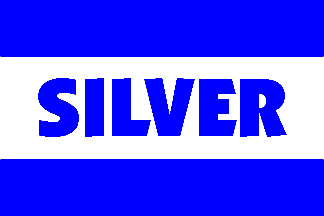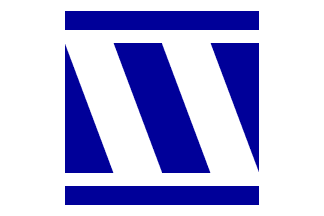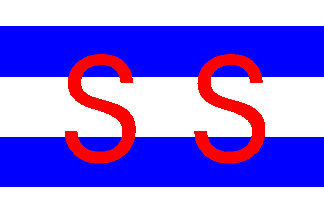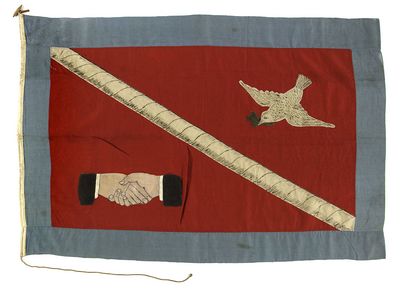 image
by Jarig Bakker,
based on the website of the National
Maritime Museum.
image
by Jarig Bakker,
based on the website of the National
Maritime Museum. 
Last modified: 2006-02-18 by rob raeside
Keywords: sheaf steam | shell | silver | map: africa | pg | sally | sfms | ws&co | handshake |
Links: FOTW homepage |
search |
disclaimer and copyright |
write us |
mirrors
 image
by Jarig Bakker,
based on the website of the National
Maritime Museum.
image
by Jarig Bakker,
based on the website of the National
Maritime Museum.
From the website of the National
Maritime Museum, the house flag of the Silver Line Ltd., London. A
rectangular blue and white triband with the word 'SILVER' in blue across the
centre stripe. The flag is made of a wool and synthetic fibre bunting. It has a
cotton hoist and is machine sewn."
Jarig Bakker, 28 August 2004
Silver Lines Ltd. Formed 1925 by Stanley & John Thompson Ltd. with early
sources showing the flag under their name. Most showed the bands as being equal
and some, principally
Talbot-Booth (1936) showed a silver band
with black letters. Harnack in his "Ships & Shipping" series showed both
versions in different sections. Talbot-Booth in 1942 noted that the silver
funnel had recently become white and at the same time, without comment changed
the flag band to white and lettering to blue.
Neale Rosanoski, 17 March 2005
 image
by António Martins-Tuvālkin
image
by António Martins-Tuvālkin
In 1956 the company amalgamated with and absorbed Dene Shipping Co. Ltd. and
apparently at first used their livery being a flag of 5 diagonal bands of blue
and white from upper hoist to lower fly which is
flown by the LJC liveries chart of
1966.
Neale Rosanoski, 17 March 2005
Loughran (1979) however shows a different version of 7 white and blue diagonal bands from lower hoist to upper fly. Whichever one of these was correct, and it was probably the LJC chart as its funnel showing bands sloping the same way as the flag is confirmed by ship photos, there was a further change to white with a panel of the LJC version flag between top and bottom further blue panels slightly separated by the field:
 image
by António Martins-Tuvālkin
image
by António Martins-Tuvālkin
The
date of adoption is not known but it is noted in an article in the
February 1969 "Marine News" of the World Ship Society. The company
itself was taken over in 1974 as part of Shipping Industrial Holdings.
It disappearing from Lloyds Shipowners in the latter 1980s but
surfaced again a decade later as a subsidiary of the Vlasov Group (now
V. Ships Group). It has since disappeared again.
Neale Rosanoski, 17 March 2005
 image
by Jarig Bakker, 29 December 2004
image
by Jarig Bakker, 29 December 2004
Silvertown Services Shipping Ltd., London - five horizontal stripes of white
and blue; red "SS".
From Scott, R.M., The Caltex book of Flags and Funnels, Capetown, Caltex Africa
Ltd. (1959).
Jarig Bakker, 29 December 2004
Silvertown Services Shipping Ltd. A Tate & Lyle short lived company which was
merged with an associate in 1963 to form Sugar Line Ltd. This version is
supported by a February 1969 Marine News article whereas Stewart 1963 shows the
flag bands being equal, as does
US Navy's 1961, but the latter shows what are
presumably meant to be silver bands instead of white.
Neale Rosanoski, 17 March 2005
 image
from
Port Cities
image
from
Port Cities
located by Jan Mertens, 7 February 2005, provided by London Borough Tower Hamlets
The house flag of the Silvertown Telegraph Works, a subsidiary of the India Rubber, Gutta Percha and Telegraph Works Company. The parent company was founded in 1852 by Samuel Winkworth Silver, who gave his name to the district on the north bank of the Thames. The company stopped making telegraph equipment around 1930, and eventually became part of BTR Industries (formerly the British Tyre and Rubber Company). This later merged with Siebe to become Invensys.
![[Wm. Sloan & Co. houseflag]](../images/g/gb~wsc.gif) image by
Jarig Bakker,
based on the website of the National
Maritime Museum.
image by
Jarig Bakker,
based on the website of the National
Maritime Museum.
From the website of the National
Maritime Museum, the house flag of William Sloan and Co., Glasgow. A
rectangular blue flag with a white diamond bearing the red letters 'WS & Co'.
The flag is made of a wool and synthetic fibre bunting. It has a cotton hoist
and is machine sewn. A rope and toggle is attached."
Jarig Bakker, 4 September 2004
Wm. Sloan & Co. Originated 1825 as the St. Rollox Shipping Co. with sailing
vessels carrying chemicals for the works at St. Rollox which was operated by an
uncle of William Sloan. This company used a blue flag with the white letters "St.R"
over "Co.". I have no information on the formation of William Sloan & Co. though
it could have resulted from the advent of their 1st steamship in 1852 and
resulted in the first Sloan flag which was a blue pennant with the white letters
"W.S.Co" with the "o" being enhanced and the other letters being of equal
height. This flag was apparently also associated with the St. Rollox company,
presumably as managers. By Lloyds 1912 the Sampson flag is shown although Brown
1926 shows a blue pennant with the white letters "WS" but this, like the version
shown by the Journal of Commerce in their 1966 chart of blue with the white
letters "WS&Co", are probably incorrect.
Neale Rosanoski, 24 May 2004
![[Sir William Reardon Smith & Sons Ltd. houseflag]](../images/g/gb~s0967.gif) image
by Phil Nelson, 11 April 2000
image
by Phil Nelson, 11 April 2000
from Stewart and Styring's Flags, Funnels and Hull Colors 1963
Sir W. Reardon Smith & Sons, Cardiff: red, a large black letter `S' (with
serifs) in the centre, taking up about one third of the flag's width and four
fifths of its height. Stewart and Styring's show
it as `Sir William Reardon Smith & Sons Ltd.', but letter without serifs; I
checked the on-line 1912 Lloyds Flags & Funnels and found this flag under No.
749 on p. 38 as `W.R.
Smith & Son, Cardiff" next to No. 750 (`P. Samuel & Son, Ltd., Cardiff'),
exactly the same but for the serifs. It must have been difficult to distinguish
between them unless you recognized the ships of course.
Jan Mertens, 4 June 2004